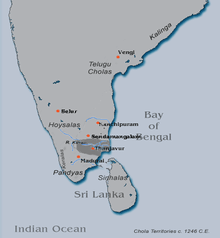Rajendra Chola III
| Rajendra Chola III | |
|---|---|
| Parakesari | |
|
Chola territories c. 1246 CE | |
| Reign | 1246–1279 CE |
| Predecessor | Rajaraja Chola III |
| Successor | Unknown |
| Born | Unknown |
| Died | ?1279 CE |
| Burial | Unknown |
| Queen | Cholakulamadeviyar |
| Issue | Unknown |
| Father | Rajaraja Chola III |
| Religion | Hinduism,Shaivism |
| List of Chola kings | ||||||||||||||||||||||||||||
|---|---|---|---|---|---|---|---|---|---|---|---|---|---|---|---|---|---|---|---|---|---|---|---|---|---|---|---|---|
| Early Cholas | ||||||||||||||||||||||||||||
| Interregnum (c. 200 – c. 848) | ||||||||||||||||||||||||||||
| Medieval Cholas | ||||||||||||||||||||||||||||
|
||||||||||||||||||||||||||||
| Later Cholas | ||||||||||||||||||||||||||||
|
||||||||||||||||||||||||||||
| Related dynasties | ||||||||||||||||||||||||||||
|
||||||||||||||||||||||||||||
| Chola society | ||||||||||||||||||||||||||||
Rajendra Chola III was the son of Rajaraja Chola III who came to the Chola throne in 1246 CE. Although his father Rajaraja III was still alive, Rajendra began to take effective control over the administration. Rajendra was a much abler king than his father and tried to stop the rapid decline the Chola kingdom was experiencing due to the incompetence of Rajaraja III.
Attempts at recovery
As a capable prince, Rajendra could not standby and watch the influence and prestige of the empire go down. He began to take active part in the official duties as soon as he was installed the heir apparent in 1246. Although Rajaraja III continued to rule in name for a few more years, he was effectively sidelined by Rajendra III.
By 1250 CE Rajendra began his strenuous attempts at regaining some of the lost prestige and started his painstaking program of recovery. Inasmuch as the entire system of the Cholas was becoming degenerate.
Pandyan expansion
Sadayavarman Sundara Pandyan I ascended the Pandya throne in 1251 CE and in him the Pandyan kingdom found a leader with ability and valour. By 1258, he had the warlike Cholas to retreat once again and forced the Hoysalas to retreat to the Mysore plateau.
End of the Chola dynasty
This sudden rising tide of Pandya power once more brought the Cholas and the Pallavas together. They gave battle to the Pandyas and in 1279 CE, this was the last war that we hear of Cholas and Pallavas. Both of them either perished in this war or disappeared from scene altogether but gallantly. Rajendra-III towards the end of his time and that of the Chola lineage, was forced even though owing more to personal resource crunch than to his unwillingness to fight enemies, to go on the defensive against the Pandyas. In 1264 CE, Jatavarman Sundara Pandyan I fought and was defeated by the Hoysala King Vira Someshwara as attested by his inscription at the Sri Ranganathaswamy Temple in Srirangam. The Pandyan king finally turned against the resourceless and weakened Cholas and Pallavas. His successor Maaravarman Kulasekara Pandyan I it seems met the Cholas somewhere between Tiruchy and Thanjavur and defeated the combined armies of Rajendra Chola III and later also defeated the Hoysalas under Ramanatha. This was the end of Chola power in South India. The Pandyas under Maaravarman Kulasekara Pandyan I seem to have gone up to Gangaikonda Cholapuram and destroyed the Chola fort and caused extensive damanage to the outer wall of the temple at Gangaikonda Cholapuram. These acts, it appears, effectively signalled the end of the Chola Kingdom along with that of Pallavas, for we do not hear of any Chola or Pallava king at either Gangaikonda Cholapuram or Kanchi, respectively, even though a certain Tribhuvanaviradeva of Chola line briefly ruled between 1331 and 1332 before disappearing completely from the scene. However, the known period of rule of Jatavarman Sundara Pandyan was between 1246 or 1251–1268 after which he was succeeded by Maravarman Kulasekhara, assisted by his son Jatavarman Vira Pandiyan, while the rule of Rajendra-III was definitely up to 1279 CE. It appears after routing the Cholas and absorbing all their territories, the Pandya kings concentrated on their other conquests.
There are no confirmed reports of Rajendra Chola III have been killed in the battlefield by the Pandyas. Some historians claim he ruled in obscurity from Gangaikonda Cholapuram up to 1280 after which there are no inscriptions found of the Cholas.
| Preceded by Rajaraja Chola III |
Chola 1246–1280 CE |
Succeeded by Pandya rule |
Notes
- Nilakanta Sastri, K. A. (1935). The CōĻas, University of Madras, Madras (Reprinted 1984).
- Nilakanta Sastri, K. A. (1955). A History of South India, OUP, New Delhi (Reprinted 2002).
